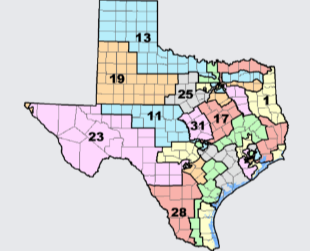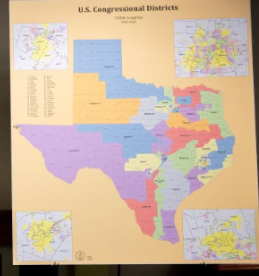Governor Greg Abbott has signed a new congressional map that targets five Democratic-held seats and reshapes the balance of power in Texas for the decade ahead.
What to Know:
- Five Democratic-held districts are redrawn into new Republican-leaning strongholds.
- The biggest partisan swings occur in Al Green’s CD 9 (D+44.1 → R+19.9) and Julie Johnson’s CD 32 (D+23.8 → R+17.7).
- Greg Casar, Henry Cuellar, and Vicente Gonzalez also see their districts shift sharply to the right.
- Democrats are packed into fewer, ultra-safe seats like CD 18, which strengthened from D+39.8 → D+54.9.
- Several incumbents, including Green, Johnson, and Casar, are expected to seek new district numbers to remain competitive.
Texas Governor Greg Abbott’s signature on the new congressional map marks one of the most aggressive political redraws in modern Texas history. The plan, known as Plan C2333, uses population growth and suburban expansion to reshape the electoral battlefield.

Analysis of Plan C2333 via Dave’s Redistricting App, The Downballot, and the Texas Capitol Data Portal
For Republicans, it is a strategic victory that locks in long-term control of the state’s delegation. For Democrats, it is a five-seat gut punch that weakens their presence in fast-growing regions once seen as future blue territory.

Screenshot from District Population Analysis with County Subtotals, Plan C2333
The new map is not simply about protecting incumbents. It reflects a broader shift toward a permanent campaign mindset, where structural advantages are designed into the system itself. In Texas, that means turning once-competitive suburbs into red walls and consolidating Democratic voters into a handful of safe urban districts.
The Engineered Flip
Few changes are as sweeping as those to Al Green’s CD 9, which moves from a comfortable Democratic advantage to a commanding Republican lead. The district retains only three percent of its current population. Julie Johnson’s CD 32 faces a similar fate, swinging more than forty points toward Republicans. Greg Casar’s CD 35 also turns from a progressive base into a Republican-leaning seat with an R+10 margin.

Rep. Al Green (left), Rep. Julie Johnson (middle), Rep. Greg Casar (right)
The redraws were crafted with surgical precision. Democratic neighborhoods were carved out and replaced with Republican-heavy areas from surrounding counties. The result is a map that forces Democratic incumbents to either compete in newly hostile districts or run in unfamiliar territory. The shift is not just about flipping seats, but about forcing the opposition to spend time and resources defending ground they once took for granted.

Screenshot of proposed map taken from Democracy Docket
At the same time, the map creates deeper blue havens such as CD 18, which becomes one of the safest Democratic seats in the state. This is the essence of packing and cracking: stack Democratic votes in a few districts to secure Republican advantages everywhere else.
The Border Realignment
Along the southern border, the new lines strike directly at two incumbents who have managed to hold on through turbulent cycles. Henry Cuellar’s CD 28 and Vicente Gonzalez’s CD 34 were already competitive, but now lean decisively Republican. Cuellar’s district moves to R+10.4 and Gonzalez’s to R+10.1, numbers that virtually guarantee Republican presidential victories.

Rep. Henry Cuellar (left), Rep. Vicente Gonzalez
These changes capitalize on recent GOP gains in the Rio Grande Valley. Republicans have made steady inroads among Hispanic and working-class voters who have grown skeptical of national Democratic messaging. The new map locks in those realignments, reflecting a Republican strategy that sees the border not as a liability but as an opportunity for long-term growth.
Why It Changes Everything
With Plan C2333, Republicans are not just consolidating control; they are future-proofing it. The map reduces the number of truly competitive seats, meaning fewer races where national Democrats can realistically compete. That forces Democrats to decide whether to pour millions into districts they are unlikely to win or to retreat to safer territory and risk appearing defeated.

Screenshot from YouGov
The implications go beyond Texas. The state’s delegation is one of the largest in the country, and its composition affects national party strategy. By redrawing the map to secure five additional seats, Texas Republicans strengthen the GOP’s position in Congress, giving the party a firmer foundation ahead of the 2026 midterms and the next presidential race.
The map also sets a precedent for how other states may act in future cycles. Population shifts and suburban growth once gave Democrats hope that Texas might turn purple. Abbott’s map turns that hope into a harder climb, proving that political geography can still outweigh demographic trends.
Wrap Up
Lawsuits challenging the new boundaries are inevitable, but even a partial legal victory is unlikely to change the overall structure. The political reality is that Republicans have created a map designed to endure. Democrats will need to develop new strategies to re-engage suburban voters and rebuild momentum in communities that have been carved apart.
The next test will come quickly. Several incumbents must decide whether to defend their current seats or pivot to safer ground, setting up potential primary battles and regional realignments. Regardless of individual outcomes, the broader message is clear. Texas Republicans are no longer playing defense. They are drawing a future in which their dominance is structural, not seasonal.





